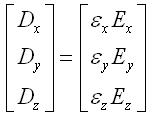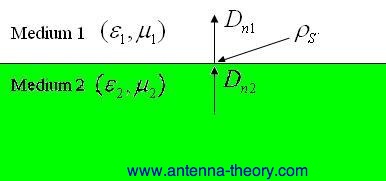Electric Flux Density (D-Field)
|
The Electric Flux Density (usually written as the vector quantity D) is often used in electromagnetics.
While we won't give it a rigorous definition here, it can be sufficiently understood for the purposes of antenna theory
as being proportional to the
Electric Field. The proportionality constant
depends on the medium being analyzed, and is known as the
permittivity:
 The electric flux density has units of charge/area (Coulombs/meter-squared or [C/m^2]). The permittivity is often frequency-dependent, and is sometimes anisotropic (implying the permittivity depends on which direction the fields are in):
 In the most general case the E-field is related to the the electric flux density by a 3x3 matrix, which is also frequency-dependent. The only other major result in relation to the electric flux density involves the continuitiy of fields across boundaries. Consider two materials as shown in the figure below. 
The normal component of the electric flux density
will be discontinuous at the boundary by an amount equal to the surface charge density
 This relation holds at every point along the interface of a material discontinuity (medium change). |

Custom Search
|
 , which has units of charge/area (Coulombs/meter-squared). This can
be written mathematically as:
, which has units of charge/area (Coulombs/meter-squared). This can
be written mathematically as: